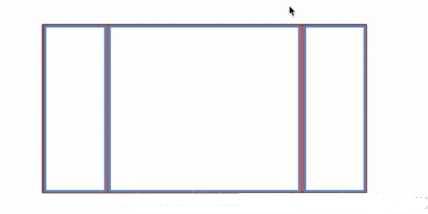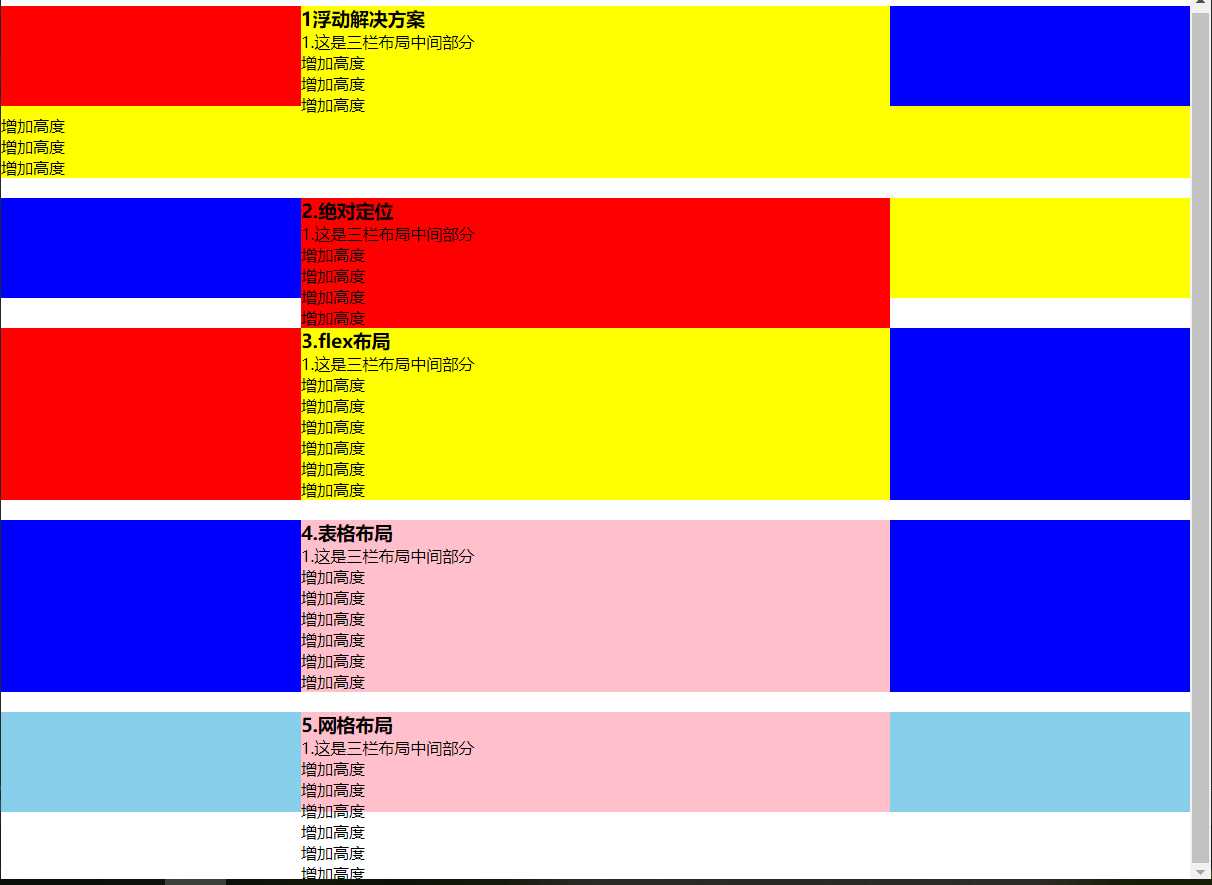假设高度已知,请写出三栏布局,左栏、右栏宽度300px,中间宽度自适应。

这道题本身的难度并不大,我们在布局页面的时候,写个三栏布局还是挺简单的。但是如果在面试的时候遇到这道题,就没有那么简单了。看似简单的一道题,想把它答好是不简单的。往往越简单的题越不好答。如果看到这题只想到了浮动和绝对定位,那这题你连及格都及格不了。
下面是5种三栏布局的方法。
在写布局代码之前,先写两段公共的样式,此段写在头部。
样式
<style media="screen">
html *{
padding: 0;
margin: 0;
}
.layout article div{
min-height: 100px;
}
</style>
1. 浮动布局
<!--浮动布局 -->
<section class="layout float">
<style media="screen">
.layout.float .left{
float:left;
width:300px;
background: red;
}
.layout.float .center{
background: yellow;
}
.layout.float .right{
float:right;
width:300px;
background: blue;
}
</style>
<h1>三栏布局</h1>
<article class="left-right-center">
<div class="left"></div>
<div class="right"></div>
<div class="center">
<h2>浮动解决方案</h2>
1.这是三栏布局的浮动解决方案;
2.这是三栏布局的浮动解决方案;
</div>
</article>
</section>
浮动布局是有局限性的,浮动元素是脱离文档流,要做清除浮动,这个处理不好的话,会带来很多问题,比如高度塌陷等。
浮动布局的优点就是比较简单,兼容性也比较好。只要清除浮动做的好,是没有什么问题的。
延伸:1.如果中间内容增加,会发生什么,为什么?(原因掉下去的高度是因为左边没有浮动的遮挡)

2.你知道哪些清除浮动的方案?每种方案的有什么优缺点?
https://www.cnblogs.com/SallyShan/p/11470549.html
2.绝对定位布局
<!-- 绝对布局 -->
<section class="layout absolute">
<style>
.layout.absolute .left-center-right>div{
position: absolute;
}
.layout.absolute .left{
left:0;
width: 300px;
background: red;
}
.layout.absolute .center{
left: 300px;
right: 300px;
background: yellow;
}
.layout.absolute .right{
right:0;
width: 300px;
background: blue;
}
</style>
<h1>三栏布局</h1>
<article class="left-center-right">
<div class="left"></div>
<div class="center">
<h2>绝对定位解决方案</h2>
1.这是三栏布局的绝对定位解决方案;
2.这是三栏布局的绝对定位解决方案;
</div>
<div class="right"></div>
</article>
</section>
绝对定位布局优点,很快捷,设置很方便,而且也不容易出问题,你可以很快的就能想出这种布局方式。
缺点就是,绝对定位是脱离文档流的,意味着下面的所有子元素也会脱离文档流,这就导致了这种方法的有效性和可使用性是比较差的。
3.flex布局
<!-- flexbox布局 -->
<section class="layout flexbox">
<style>
.layout.flexbox{
margin-top: 110px;
}
.layout.flexbox .left-center-right{
display: flex;
}
.layout.flexbox .left{
width: 300px;
background: red;
}
.layout.flexbox .center{
flex:1;
background: yellow;
}
.layout.flexbox .right{
width: 300px;
background: blue;
}
</style>
<h1>三栏布局</h1>
<article class="left-center-right">
<div class="left"></div>
<div class="center">
<h2>flexbox解决方案</h2>
1.这是三栏布局的felx解决方案;
2.这是三栏布局的flex解决方案;
</div>
<div class="right"></div>
</article>
</section>
felxbox布局是css3里新出的一个,它就是为了解决上述两种方式的不足出现的,是比较完美的一个。目前移动端的布局也都是用flexbox。
felxbox的缺点就是不能兼容IE8及以下浏览器。
4.表格布局
<!-- 表格布局 -->
<section class="layout table">
<style>
.layout.table .left-center-right{
width:100%;
height: 100px;
display: table;
}
.layout.table .left-center-right>div{
display: table-cell;
}
.layout.table .left{
width: 300px;
background: red;
}
.layout.table .center{
background: yellow;
}
.layout.table .right{
width: 300px;
background: blue;
}
</style>
<h1>三栏布局</h1>
<article class="left-center-right">
<div class="left"></div>
<div class="center">
<h2>表格布局解决方案</h2>
1.这是三栏布局的表格解决方案;
2.这是三栏布局的表格解决方案;
</div>
<div class="right"></div>
</article>
</section>
表格布局在历史上遭到很多人的摒弃,说表格布局麻烦,操作比较繁琐,其实这是一种误解,在很多场景中,表格布局还是很适用的,比如这个三栏布局,用表格布局就轻易写出来了。还有表格布局的兼容性很好,在flex布局不兼容的时候,可以尝试表格布局。
表格布局也是有缺陷的,当其中一个单元格高度超出的时候,两侧的单元格也是会跟着一起变高的,而有时候这种效果不是我们想要的。
表格的缺点:https://www.cnblogs.com/SallyShan/p/11617322.html
5.网格布局
<!-- 网格布局 -->
<section class="layout grid">
<style>
.layout.grid .left-center-right{
width:100%;
display: grid;
grid-template-rows: 100px;
grid-template-columns: 300px auto 300px;
}
.layout.grid .left-center-right>div{
}
.layout.grid .left{
width: 300px;
background: red;
}
.layout.grid .center{
background: yellow;
}
.layout.grid .right{
background: blue;
}
</style>
<h1>三栏布局</h1>
<article class="left-center-right">
<div class="left"></div>
<div class="center">
<h2>网格布局解决方案</h2>
1.这是三栏布局的网格布局解决方案;
2.这是三栏布局的网格布局解决方案;
</div>
<div class="right"></div>
</article>
</section>
网格布局也是新出的一种布局方式,如果你答出这种方式,也就证明了你的实力,证明你对技术热点是有追求的,也说明你有很强的学习能力。
网格布局的优点:可以将页面分成具有简单属性的行和列
缺点:兼容性不好。但目前看来 grid布局和flex布局的兼容性差不多,那么用哪种方式更好呢:一维用flex布局,二维用grid ,
详细内容可参考https://juejin.im/entry/5a2f458af265da432840d1fd
效果图:以下内容是如果在中间部分高度不固定,那么哪种方法还可以正确使用,可以看出flex布局和表格布局是能够正常显示的。

